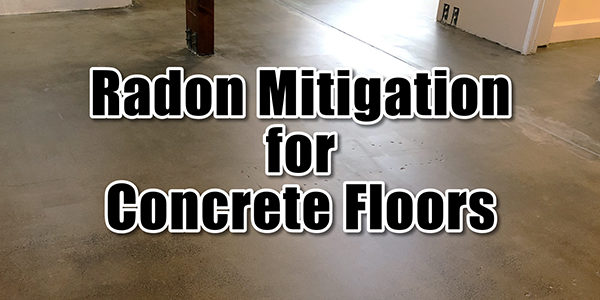Radon Mitigation In Concrete
Did you know that radon gas is one of the leaders in causing lung cancer in the US? Radon mitigation in concrete slabs can be expensive to fix but there are do-it-yourself solutions. We all know mitigating radon gas in your home is extremely important but where do you start?
Testing
The first step in mitigating radon gas is get your property tested. No level of radon gasses is considered safe. Radon test kits are available for many different prices online and are worth the investment. Radon levels fluctuate naturally on a daily and seasonal basis. A short term test might not be an accurate assessment of a property’s average radon level, but are recommended for initial testing to quickly determine unhealthy conditions. The property owner can test for radon using passive or active devices placed in the building. Some devices are promptly sent to a laboratory for analysis, others calculate the results on-site.
Solutions
One way of completely eliminate radon gasses from penetrating through your concrete by increasing the density of the slab. This can be done by applying a deep penetrating sealer like Creto DPS to the concrete. This sealer crystalizes through the concrete, filling the voids where gasses can pass, and increasing the density of the concrete. This won’t eliminate the gasses completely but it will drastically reduce the permeation of the radon. Here’s how you do it…
Game Plan For Radon Mitigation In Concrete
First off, all the cracks and expansion joints have to be filled and repaired. A cement based concrete patch, epoxy filler, or polyurethane filler can be used. Make sure that they are flush with the rest of the concrete for esthetic reasons, and so you don’t trip over them!
Secondly, you want to clean your concrete surfaces by stripping off any adhesives, paint, or any other contaminants from the floors. For instance, the penetrating sealer won’t soak into the slab if another surface sealer is blocking the way. So strip the floor all the way to the bare concrete and then you’re good to go. Then apply Creto Deep Penetrating Sealer to the raw concrete. Creto DPS usually takes between 24 – 72 hours to fully cure ( depending on the temperature ).
Thirdly, a non-breathable sealer can be applied. Non-breathable sealers are surface ( or topical ) sealers that cover the surface of the concrete. I would recommend using either E10 Epoxy sealer or PolyShine. Both are non-breathable and leave the concrete with a glossy sheen. Usually I apply two coats to increase the durability and sheen of the sealer. This will completely block any radon that’s still permeating through the slab.
This three step radon mitigation system for concrete flooring is a great, cost effective, solution for abating radon gasses. This entire process can be done as a DIY ( do-it-yourself ) project for minimal costs.
So if your property is having problems with radon gasses and you would like to drastically reduce or eliminate them completely, go ahead and follow the instructions I’ve laid out for you above. It will save you thousands of dollars and give you the same great results that a highly paid radon mitigation company would give you!
Featured Products
Here’s the links to the sealers described above:
Deep Penetrating Sealer (DPS)
E10 Epoxy Sealer
Poly Shine
Find out more here: https://en.wikipedia.org/wiki/Radon_mitigation








